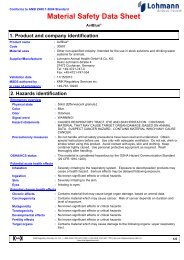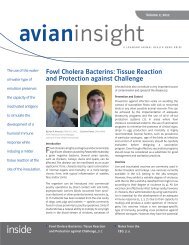Create successful ePaper yourself
Turn your PDF publications into a flip-book with our unique Google optimized e-Paper software.
1240.AvianInsight Vol1-05 1/10/05 3:13 PM Page 14 avian insightfrom the president…Dave Zacek,President of<strong>Lohmann</strong><strong>Animal</strong><strong>Health</strong>International,Gainesville,Georgia, USAIntroducing a New VaccineWe are very pleased to introduceAviPro ® 101 Coryza Gold, a newvaccine for protection against Coryza(H. paragallinarum). Our new vaccinecontains representative strains of typeA, B and C H. paragallinarum to providebroad protection against a significantvariety of expected challenges.In addition, we are using a proprietaryadjuvant described as water-in-oil-inwater(WOW). This new adjuvant isdesigned to provide long duration ofprotection without causing harsh postvaccinationreactions.AviPro ® 101 Coryza Gold is our wayof answering customer demand forimproved efficacy and improved durationof immunity against this disease.Practical Development of New Vaccines<strong>Lohmann</strong> <strong>Animal</strong> <strong>Health</strong> Internationalhas produced a steady stream of newavian vaccines since our inception in2000. Each vaccine was developed inresponse to specific customer needs.Our approach has been practical andV.1 2005“close to the user.” Look to us fora continuous supply of new avianvaccines. Our company is focused ononly avian vaccines. This allows us todevote a significant part of our revenuesto developing new vaccines.And, to learn how to use AviPro ® 101Coryza Gold in your operation, contactyour LAHI Area Manager or LAHIVeterinarian for more information.<strong>Lohmann</strong> <strong>Animal</strong> <strong>Health</strong> International is a leading manufacturer and supplier of poultry biologics for the U.S. and international vaccine markets. Based inGainesville, GA, LAHI maintains production facilities in Vineland, NJ, and Waterville, ME. LAHI is a member of the PHW Group, a 32-company enterprisethat produces avian vaccines and poultry for the global market.Gainesville, GA 305011146 Airport Parkwayavian insight For further information: 770.532.3627 • 800.655.1342 • www.lahinternational.comavian insightA LOHMANN ANIMAL HEALTH INTERNATIONAL NEWS BRIEF V.1 2005EFFICACY AND DURATION OF IMMUNITY STUDIES INVOLVING AHAEMOPHILUS PARAGALLINARUM BACTERIN IN A NOVEL OIL EMULSIONKaren Burns Grogan A , Patricia S. Wakenell B , Ken Takeshita C , Eric J. Lovell DATechnical Service Veterinarian, <strong>Lohmann</strong> <strong>Animal</strong> <strong>Health</strong> International, Gainesville, GABAssociate Professor, Population <strong>Health</strong> and Reproduction, College of Veterinary Medicine, University of California at Davis, Davis, CA.CArea Manager/Technical Service Veterinarian, <strong>Lohmann</strong> <strong>Animal</strong> <strong>Health</strong> International, Vacaville, CADConsultant Veterinarian, <strong>Lohmann</strong> <strong>Animal</strong> <strong>Health</strong> International, Pensacola, FLIntroductionHaemophilus paragallinarum (H. paragallinarum)is the etiology of InfectiousCoryza, a highly contagious, acuterespiratory disease of poultry. Thisdisease can be economically devastatingin tropical and subtropical parts ofthe world, where it is more commonlyreported. Clinical signs of the diseaseinclude nasal exudates with a characteristicodor, sinusitis, conjunctivitis,with depression and lethargy. Infectedlaying flocks can experience a reductionin egg production by 40-100% andwill typically recover with treatment.Even with the use of commerciallyavailable bacterins, affected flocks canexperience production drops of 5-10%.H. paragallinarum isolates were originallygrouped into serovars by Page in1962 using a plate agglutination test.Isolates were placed into one of threeserovars, A, B, or C. In 1983, anotheridentification scheme was reported, theKume scheme, which grouped isolatesusing a hemagglutination inhibitiontest. The Kume scheme was then adaptedIn this issue of avian insight:Efficacy and Duration of ImmunityStudies Involving a HaemophilusParagallinarum Bacterin in aNovel Oil Emulsion ..............p.1From the President ...............p.4Nasal exudates seen in infectious coryzato correlate with the existing Pageserovars. Additionally, more recentwork has reported a hemagglutinationinhibition test for the Page scheme,resulting in the most accepted identificationsystem for serovar identification.Serovar distinction remains critical todiscussions of bacterins since onlyhomologous protection is known toexist, meaning inactivated antigens ofgroup A will only protect to group A.There is no cross-group protection.Cross protection is reported to existamong isolates within serovars.Characteristic sinusitis present in infectious coryzaThe bacterins produced against H.paragallinarum are reported to exhibitadverse post vaccination reactions,especially those in water-in-oil emulsions.These reactions can result indecreased feed consumption, a delay insexual maturity, and a reduction in totalnumber of eggs produced per hen. Ingeneral, the bacterins that are waterbasedin aluminum hydroxide offer lesspost vaccination reaction, but protectioncan be reduced. The ideal vaccinewould include all three serovars incorporatedinto an adjuvant that delivered theantigens to the immune system stimulatinga long-lived, high level of immunitywithout adverse reactions.To minimize the field problems withcoryza bacterins, <strong>Lohmann</strong> <strong>Animal</strong><strong>Health</strong> International (LAHI) has developedand licensed a new commercialH. paragallinarum bacterin, presentedin a novel oil emulsion. The product,Coryza ABC Gold, contains highlyantigenic quantities of representativestrains from the three Page serovars ofH. paragallinarum. In order to evaluatethe bacterin in the novel adjuvant, thefollowing studies were performed todemonstrate the reduction in tissuereaction, protection from challenge andduration of immunity.continued on page 2
1240.AvianInsight Vol1-05 1/10/05 3:13 PM Page 22 avian insightV.1 20053 avian insightV.1 2005continued from page 1continued from page 2Study 1 – Evaluation of Tissue ReactivityScoreTable 1. Scoring system to evaluate SQ injectionsDescription of Lesion0 No visible lesion1- No adjuvant remnants with slight inflammation; ortraces of emulsion with no inflammation1 Remnants of adjuvant with only minor inflammation1+ Remnants of adjuvant with some edema and/orpetechial hemorrhage deeper in the tissue2 Single or multiple well-defined granulomas, less then1 inch in size3 Single or multiple well-defined granulomas, 1 inch insize or greater4 Larger granulomas and/or diffused swelling of thesubcutaneous or muscle tissue with necrotic lesionsThis bacterin using a novel adjuvant containing the threeserovars of H. paragallinarum was tested against a popularwater-based commercial bacterin also containing allthree serovars. Previous field experience with this commercialwater-based product has demonstrated the desirableminimum post vaccination reaction. Groups of threeweek-oldspecific pathogen free (SPF) birds were vaccinatedsubcutaneously with either the experimental vaccineor the commercial water-based vaccine. Three weeks postvaccination, the vaccination sites of the birds were evaluatedfor adverse reaction and scored numerically with astandardized lesion scoring system. The lesion scoringsystem appears in Table 1. The experimental vaccine producedan average injection site reaction score of 0.63 comparedto the commercial water-based vaccine’s higherscore of 1.9.Table 2. Percent protection following intranasal challengeGroup Serovar Challenge % ProtectionGraph 1: Percent protection by group following challengeproduct in the novel emulsion. One hundred fifty SPFchickens, five weeks of age, were divided into six groups.Three groups were vaccinated subcutaneously in the neckwith one dose (0.5 ml) of the experimental bacterin andrevaccinated four weeks after the initial vaccination. Theremaining three groups served as non-vaccinated, challengedcontrols. At two weeks post revaccination all birdswere challenged intranasally with one of the three challengestrains of H. paragallinarum. The challenge dose variedby serovar, see Table 2 for actual challenge levels. Thechickens were observed daily for signs of facial swellingor nasal exudates for a period of ten days post-challenge.All birds were housed under conditions of high temperatureand high humidity throughout the observation period.Chickens exhibiting two consecutive days of facialswelling and/or two consecutive days of nasal exudatesduringthe observation period were considered positive for H.paragallinarum infection. Results are found in Table 2and in Graph 1.Field StudiesAs a part of the licensing procedure, the product was testedGraph 2: Lesion Score results from field-vaccinated flocksin commercial laying flocks. Birds were injectedtwice with the LAHI coryza bacterin, subcutaneouslyat ten weeks and 14 weeks of age. The flocks injectedwith Coryza ABC Gold were compared to flocksinjected with another commercially available bacterin.The parameters evaluated were tissue reaction bymanual palpation at two weeks post vaccination, mortalityfollowing injection, and production effects. Graph 2will display the tissue reaction results from oneparticipating farm.In the farms participating, no significant differenceswere observed in mortality rates, egg productionand other production parameters (feed conversion,weight gain, etc.) between groups vaccinatedwith the LAHI product as compared to the othercommercial bacterin.University Study: Duration of ImmunityTo evaluate the efficacy of the product in field-vaccinatedbirds, a university collaborated with LAHI tocomplete a challenge trial in commercial layers fromthe previous field studies. Eighty field-vaccinatedbirds at 48 weeks of age, that had received two dosesof LAHI Coryza ABC Gold, and 40 age-matchednon-vaccinated control birds were transported touniversity challenge facilities. After an acclimationStrain NameCFU per doseSerogroup A - 0083 8.3 x 10 6Serogroup B - SpRoss 6.8 x 10 5Serogroup C - Modesto 3.4 x 10 7period, birds were challenged intranasally with 0.30ml of one of three challenge strains present in thebacterin, at the following titer levels:Table 3: Results following challenge with serotypes A, B, C in48-week-old commercial layers.GroupVaccinatedNon-vaccinated# Positive% Protection# Positive% ProtectionChallenge0083 SpRoss Modesto0/20 a--100%8/10 b20%1/20 a95%7/10 b30%a,b - indicate significance at P< 0.01 by Chi Square test0/20 a100%8/10 b20%Graph 3: Percent protection following challenge with threestrains of H. paragallinarum.ConclusionsThrough the studies presented, this new H. paragallinarumbacterin has been shown to be highly effective. The productproduces immunity to all three serovarscontained, showing equal protection to challenge in bothstudies presented. University-performed challenge studiesdemonstrated effective immunity in birds at 48 weeksof age. Furthermore, in both in-house studies and fieldstudies, this new bacterin proved to be less tissue reactive,even compared to water-based products.Vaccinated A (8.46 x 10 7 CFU) 100%Non-Vaccinated A 28.6%Vaccinated B (5.64 x 10 5 CFU) 91.7%Non-Vaccinated B 20.0%Vaccinated C (8.64 x 10 7 CFU) 93.8%Non-Vaccinated C 5.6%Study 2 – Bacterin EfficacyA challenge trial was completed to prove efficacy of theLesion scoring system for this trial:0 = No palpable lesion1 = Palpable mass less than 1cm in diameter2 = Palpable mass greater than 1 cm, but less than 2cm in diameter3 = Palpable mass greater than 2 cm in diameterFor the challenge period, birds were housed underconditions of high temperature and high humidity.Challenge groups were observed for eight days postchallengefor clinical signs of coryza – facial swellingor nasal exudates. Any bird displaying clinical signsfor two consecutive days during the eight-day periodwas judged as positive for H. paragallinarum infection.Results of challenge and percent protection can befound in Table 3 and Graph 3.Developments in emulsion technology have allowedvaccine manufacturers to overcome previous negativeeffects experienced in the field with certain products;coryza bacterins are one such example. By developingan H. paragallinarum bacterin in a novel oil emulsion,Coryza ABC Gold from LAHI will alleviate previousproblems experienced with this group of products. Furtherfield studies are planned to extend the evaluation of thisproduct, including the protective effect to egg productiondrops in the face of field challenge and use in broiler breeders.continued on page 3
















